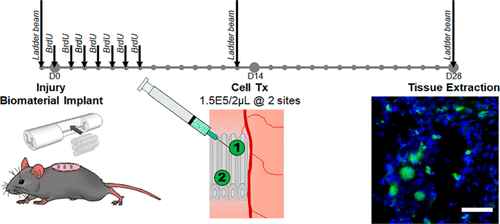当前位置:
X-MOL 学术
›
ACS Biomater. Sci. Eng.
›
论文详情
Our official English website, www.x-mol.net, welcomes your feedback! (Note: you will need to create a separate account there.)
Acute Implantation of Aligned Hydrogel Tubes Supports Delayed Spinal Progenitor Implantation
ACS Biomaterials Science & Engineering ( IF 5.8 ) Pub Date : 2020-08-31 , DOI: 10.1021/acsbiomaterials.0c00844 Andrew J Ciciriello 1, 2 , Dominique R Smith 3 , Mary K Munsell 3 , Sydney J Boyd 1 , Lonnie D Shea 3, 4 , Courtney M Dumont 1, 2
ACS Biomaterials Science & Engineering ( IF 5.8 ) Pub Date : 2020-08-31 , DOI: 10.1021/acsbiomaterials.0c00844 Andrew J Ciciriello 1, 2 , Dominique R Smith 3 , Mary K Munsell 3 , Sydney J Boyd 1 , Lonnie D Shea 3, 4 , Courtney M Dumont 1, 2
Affiliation

|
An important role of neural stem cell transplantation is repopulating neural and glial cells that actively promote repair following spinal cord injury (SCI). However, stem cell survival after transplantation is severely hampered by the inflammatory environment that arises after SCI. Biomaterials have a demonstrated history of managing post-SCI inflammation and can serve as a vehicle for stem cell delivery. In this study, we utilize macroporous polyethylene glycol (PEG) tubes, which were previously found to modulate the post-SCI microenvironment, to serve as a viable, soft substrate for injecting mouse embryonic day 14 (E14) spinal progenitors 2 weeks after tube implantation into a mouse SCI model. At 2 weeks after transplantation (4 weeks after injury), 4.3% of transplanted E14 spinal progenitors survived when transplanted directly into tubes compared to 0.7% when transplanted into the injury alone. Surviving E14 spinal progenitors exhibited a commitment to the neuronal lineage at 4 weeks post-injury, as assessed by both early and late phenotypic markers. Mice receiving tubes with E14 spinal progenitor transplantations had on average 21 ± 4 axons/mm2 regenerated compared to 8 ± 1 axons/mm2 for the injury only control, which corresponded with a significant increase in remyelination compared to the injury only control, while all conditions exhibited improved forelimb control 4 weeks after injury compared to the injury only. Collectively, we have demonstrated the feasibility of using PEG tubes to modify the implantation site and improve survival of transplanted E14 spinal progenitors.
中文翻译:

对齐水凝胶管的急性植入支持延迟脊髓祖细胞植入
神经干细胞移植的一个重要作用是重新填充积极促进脊髓损伤 (SCI) 后修复的神经和神经胶质细胞。然而,移植后的干细胞存活受到 SCI 后出现的炎症环境的严重阻碍。生物材料具有管理 SCI 后炎症的历史证明,可以作为干细胞递送的载体。在这项研究中,我们利用之前发现可调节 SCI 后微环境的大孔聚乙二醇 (PEG) 管作为可行的软基质,用于在管植入后 2 周注射小鼠胚胎第 14 天 (E14) 脊髓祖细胞进入小鼠 SCI 模型。移植后 2 周(损伤后 4 周),4. 当直接移植到管中时,3% 的移植 E14 脊髓祖细胞存活,而仅移植到损伤部位时存活率为 0.7%。幸存的 E14 脊髓祖细胞在损伤后 4 周表现出对神经元谱系的承诺,正如早期和晚期表型标记所评估的那样。接受 E14 脊髓祖细胞移植管的小鼠平均有 21 ± 4 个轴突/毫米与仅损伤对照的 8 ± 1 轴突/mm 2相比, 2再生,与仅损伤对照相比,髓鞘再生显着增加,而与仅损伤相比,所有条件在损伤后 4 周都表现出改善的前肢控制。总的来说,我们已经证明了使用 PEG 管修改植入部位和提高移植 E14 脊髓祖细胞存活率的可行性。
更新日期:2020-10-12
中文翻译:

对齐水凝胶管的急性植入支持延迟脊髓祖细胞植入
神经干细胞移植的一个重要作用是重新填充积极促进脊髓损伤 (SCI) 后修复的神经和神经胶质细胞。然而,移植后的干细胞存活受到 SCI 后出现的炎症环境的严重阻碍。生物材料具有管理 SCI 后炎症的历史证明,可以作为干细胞递送的载体。在这项研究中,我们利用之前发现可调节 SCI 后微环境的大孔聚乙二醇 (PEG) 管作为可行的软基质,用于在管植入后 2 周注射小鼠胚胎第 14 天 (E14) 脊髓祖细胞进入小鼠 SCI 模型。移植后 2 周(损伤后 4 周),4. 当直接移植到管中时,3% 的移植 E14 脊髓祖细胞存活,而仅移植到损伤部位时存活率为 0.7%。幸存的 E14 脊髓祖细胞在损伤后 4 周表现出对神经元谱系的承诺,正如早期和晚期表型标记所评估的那样。接受 E14 脊髓祖细胞移植管的小鼠平均有 21 ± 4 个轴突/毫米与仅损伤对照的 8 ± 1 轴突/mm 2相比, 2再生,与仅损伤对照相比,髓鞘再生显着增加,而与仅损伤相比,所有条件在损伤后 4 周都表现出改善的前肢控制。总的来说,我们已经证明了使用 PEG 管修改植入部位和提高移植 E14 脊髓祖细胞存活率的可行性。



























 京公网安备 11010802027423号
京公网安备 11010802027423号